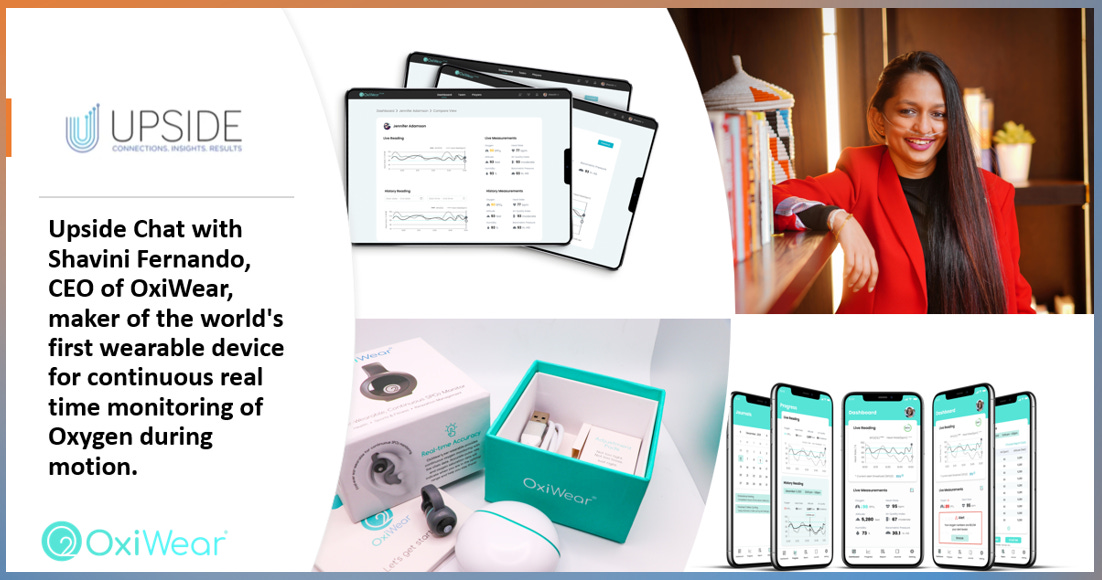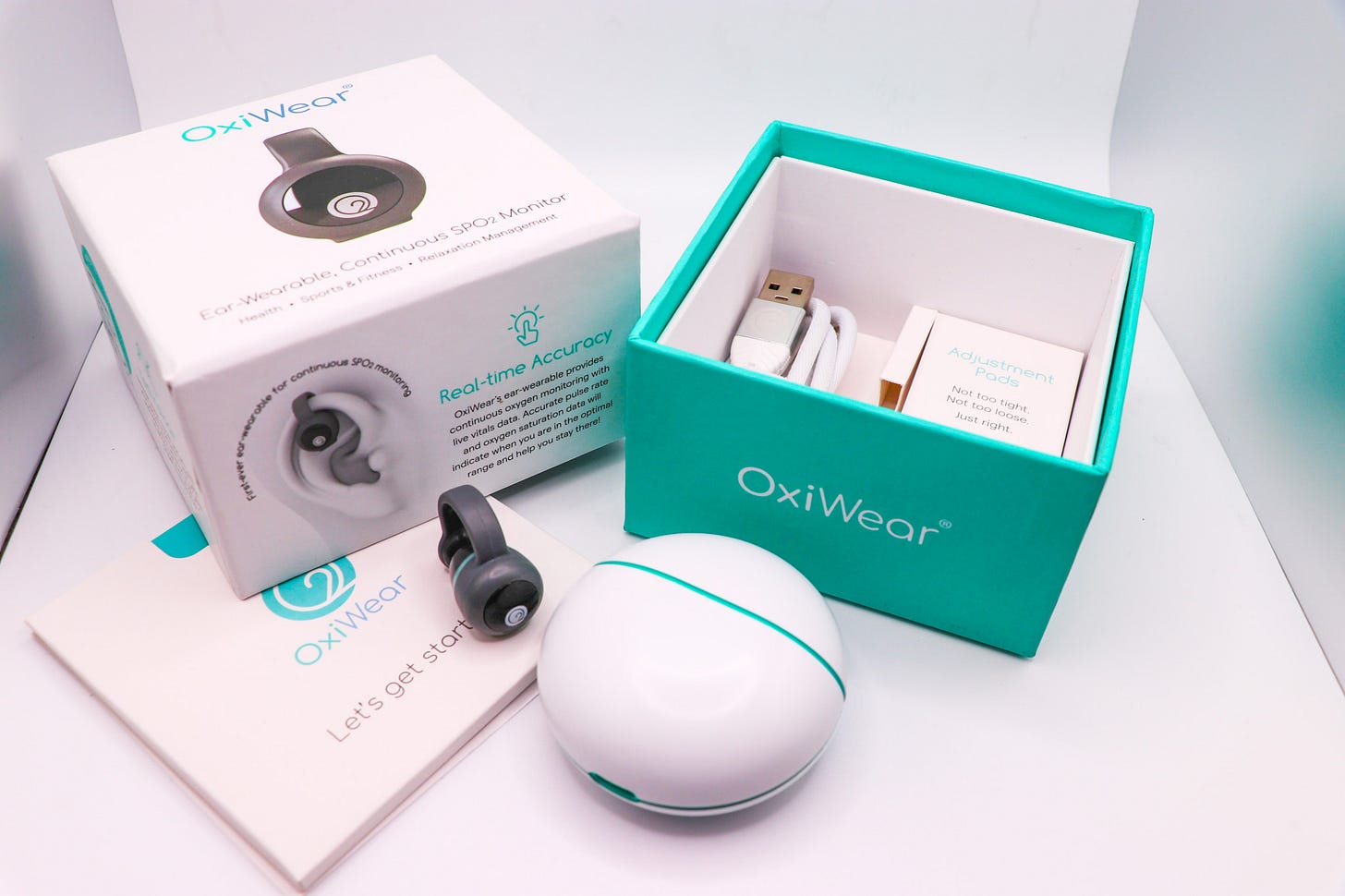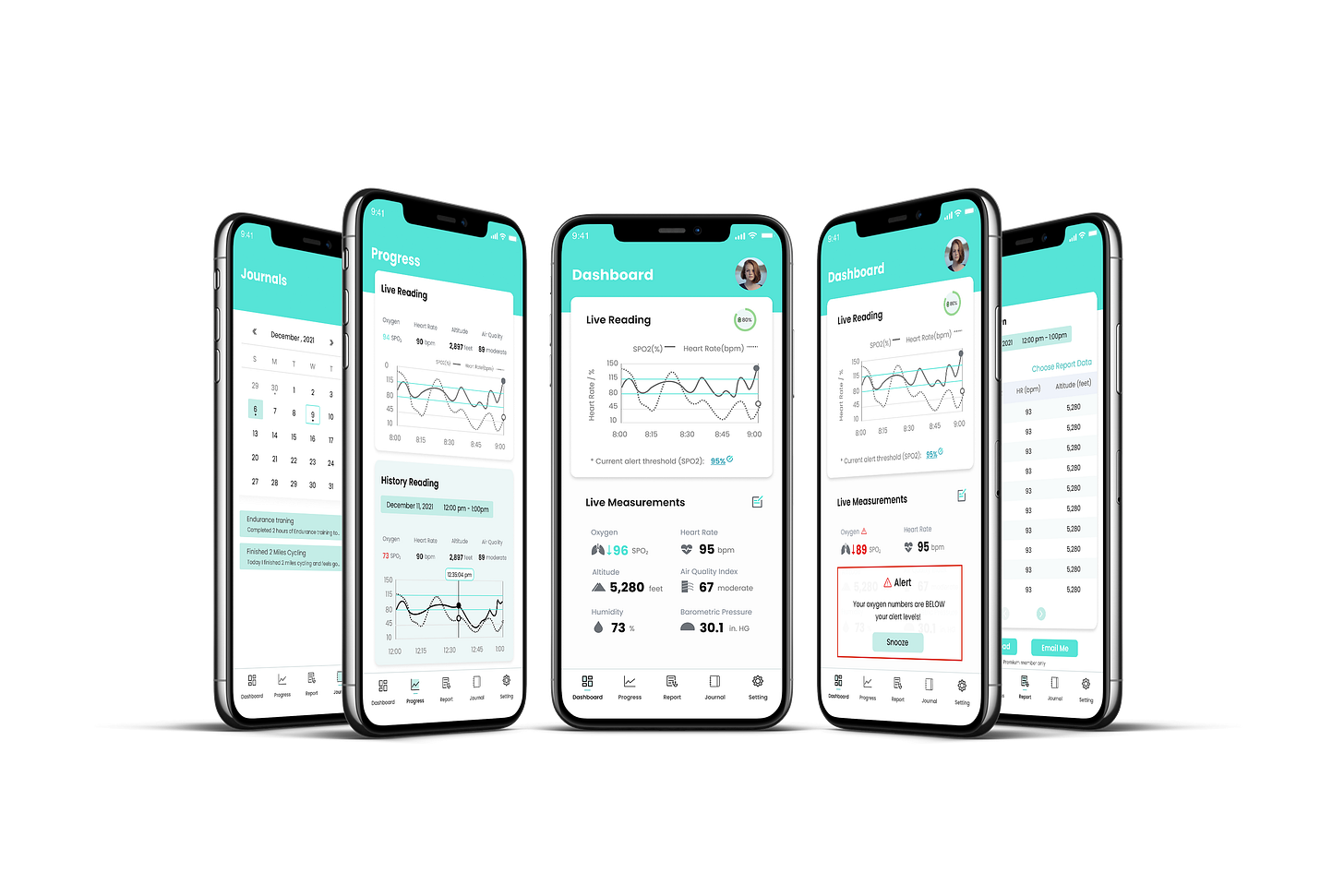This week, we have the honor to interview Shavini Fernando, CEO of OxiWear, maker of the world's first wearable device for continuous real time monitoring of Oxygen during motion.
OxiWear was developed in 2019 by Shavini, a VR/video game and web designer who suffers from pulmonary hypertension as a result of Eisenmenger Syndrome. OxiWear built a stylish ear-wearable device that continuously monitors oxygen levels and provides low oxygen alerting. OxiWear is committed to reducing patient vulnerability to hypoxic injury through wearable, continuous oxygen monitoring and low-oxygen alerting. Their mission is to increase safety and peace of mind for those prone to silent hypoxia, to reduce healthcare costs, and to save lives. OxiWear is trusted and used by top athletes and teams.
If you want to meet Shavini at our NY Summit at Citi Field on November 15, you can contact her to schedule a meeting by clicking on the button below:
Here is a picture of OxiWear product:
Here is a picture of OxiWear mobile app:
Here is a picture of the OxiWear tablet app:
Here is a video on Shavini’s story and how she came up with the idea of launching OxiWear:
📝Show Notes: Through this interview, we touched on her background, and her company and product. We also discussed the benefits for sports organizations and athletes to use her product. Lastly we talked about her competitive advantage, business model and plans for the next 12 months.
Best Quotes: Here’s some of the key discussion points and best quotes from our conversation with Shavini:
On her background as an athlete and the fact that she has a cardiac condition:
“So back in school I was a swimmer and a sprinter, but I didn't know that I had a congenital heart defect. So I couldn't do more than a hundred meters. When it comes to swimming and running all I was able to do is no more than hundreds of meters. That was my best. After that, I felt it on my chest and I was too tired and I couldn't breathe”.
“Then in 2015, I got diagnosed. Then I learned that I had a cardiac condition and that I had a hole in the heart, which was never diagnosed. So because of that, and because I was an athlete, I literally damaged both my lungs and the heart by overtraining it when I was not supposed to do it”.
“And at that time I was a video game developer and a senior project manager for a firm back home. I then came to the U.S. because the doctors in Sri Lanka said, Oh, your condition is really bad. You've got two years to live, Just enjoy life. And I think most of the athletes can relate to this. It's all about challenging ourselves. When people say, no, we want to do it and prove to them that we can do it”.
“I'm actually functioning well now because of the hole I have, because it's acting as an exhaust valve for the pressure inside for me. So for anyone who knows all the medical terms, pressure inside your heart and the lungs, which is called pulmonary hypertension, it's supposed to be one fifth of your normal hypertension, the systolic diastolic. So for a normal person, it's 20. And for me, it's 130. That's a lot more. It's six times more”.
On how she proved the doctors wrong after her diagnostic:
“So I told the doctor, I'll be back in two years and I'll show you how I'm still alive. And this was in 2015, so I already proved it. It's not too long ago. I mean, it's been eight years now. So I came to the U.S. for a second opinion. I went to John Hopkins and they said, you can't go home again. Because I'm not supposed to go in high altitude”.
“I had to restart my life and with this condition. Now I have a disease called Eisenmenger syndrome because the hole has grown over time. I literally don't have a wall between my two chambers. So my blood flows through the hole. The hole is 2. 8 centimeters long”.
“I'm like a Sherpa now because I can function well with even 50% oxygen and without physically feeling it. But that's the tricky part. That's the dangerous part. Because our bodies are so used to it now, functioning with low oxygen. Until it drops to really low levels and get in to life threatening levels, we don't physically feel it . Because it's a new normal for me now”.
On the fact that she’s had 4 cardiac arrests but she knows what to do when it happens:
“I have had so many cardiac arrests. It's like six sense to me now. I know how to revive myself. because you get three minutes until you pass out. And before that, you need to do your first aid. Your left heart needs to be forced to pump”.
“I have had 4 cardiac arrests to date. I have a supplementary oxygen at home. So what I do is until I get the heart to start again, I quickly wear the cannula and crank it up to five liters. So I have oxygen flowing in the body so that I won't pass out until I get the heart running again. Now I don't panic”.
On how she got the idea of launching OxiWear and her device capable of measuring continuous blood oxygen level in real time during motion:
“So I got a Wearable to measure my heart rate, but then the doctors were like, heart rate is not the issue. The issue is your oxygen levels. Your body is so immune to this. You don't feel when the numbers drop because heart rate going up is normal for you all. And he said, you are so used to your heart rate fluctuation, so you don't feel it physically”.
“And that's what you need to know, your oxygen levels. But there is no point in having pulse oximeters everywhere in the house, because you don't put your finger and check unless you are physically feeling wrong”.
“So then I started working on this. but before I came out, again I put my head in and asked, what's the best place to measure oxygen other than the fingertip? Because I'm not going to wear anything on the hands. And he said ear lobe is the best place because in the ICU they measure the oxygen level from the ear”.
“Because the ear has more capillaries, and you get accurate numbers. And because it's close to the brain, you actually get the cerebral numbers, and what your oxygen level supply to the brain is. That's very important. So that's how it started with OxiWear. And then after I made the prototype, all the doctors at John Hopkins were like, you need to commercialize this. And this was all before COVID. This was in 2017”.
On how her device got submitted for FDA approval and how it is being used by top athletes today for performance monitoring:
“We are just submitting our device for FDA approval for oxygen, for our accuracy levels so that it's regulated and people can get it prescribed and can be used in the hospitals, and the insurance will be covering it. But at the same time, currently we are selling it as a fitness device in the market for performance monitoring”.
“How your oxygen fluctuates is literally how your performance is, because if you're to be at your peak performance, your oxygen levels has to be above 97, just as it drops below 97, you physically start feeling it, you're tired, you're panting. Your performance goes down”.
“When you keep training, you actually build up your lung performance such as your lung and the heart function. So even if it's in high altitude, your oxygen levels doesn't drop below 97. So that's what they do in altitude training to keep building that whole heart and lung function”.
On how Oura Ring only measures the oxygen level but they are averaging it out:
“Oura does measure oxygen level, but it is done overnight and they are averaging it out. They average it for the whole night. That's what most of the devices do. Because they can't do continuous readings, anything that comes on your wrist or your hand, or anything that reflects off the bone, because your hand moves a lot. When your hand moves, it can't continuously read the oxygen level”.
“So most of them, what they do is average it overnight, and give you your whole overnight. But averaging doesn't show you when it dropped and you can't understand why it dropped, right? But if you know throughout the whole game where it dropped, you know exactly what you were doing at that time, and why it dropped”.
On the team dashboard that they offer to teams and the fact that they can also capture various data points (e.g. altitude, air quality, humidity):
“We already have a team dashboard where the coach can pull the data from, and they can add the devices once they have the players’ approval. So the player has to approve for the coach to be able to pull that data. And then they can see the whole dashboard and the data, So that they can see trends."
”But we are looking for feedback and input from the coaches to know what else we can add, and how we can improve it. That's something we are doing with a lot of fitness centers and coaches to understand how we can customize it and give more options to meet their requirements so that they can get a full 360 report of their athlete”.
“Then they can plan the whole training session. We also do environmental data. We get the altitude, air quality, humidity, all those data as well. So the coach can literally see at different locations how the athlete performs so they can strategize a game beforehand, before the event based on the location that they're supposed to be playing next. When they have data to see how they performed in a similar location at similar altitude”.
On the fact that they plan to add new sensing capabilities like VO2 level:
“We are also working on getting the VO2 level. VO2 will also be pushed in a few months so that it's not just the mVO2 max. What we are giving is just like the oxygen level, the full VO2 trend, and how the oxygen consumption looked throughout the whole thing, and then we give the VO2 max level based on all that. Then they can see how the performance throughout looked like”.
On how their device can connect to teams’ AMS platforms via an API:
“If the team requires, we can give them access to our API because we already work with remote monitoring companies and Oxygen concentrator companies where they can directly connects to our API and also to the device directly to automate and get numbers for the algorithms. That way we can give the same access to the API so that they can pull the data to their own AMS platform”.
On how teams and athletes use OxiWear:
“Currently we have some extreme athletes, Red Bull athletes, who are using it for their training. They use it to know what their endurance levels, for endurance training, and same with sports like cycling. For example we work with a training center where they train a Tour de France cyclist, who's using our device so that they can train the cyclists. like for a lot of the endurance training with athletes”.
“And in addition to that, we work with some high cardio athletes in sports like soccer who needs to run and move fast a lot, to make sure, especially during the off season, that they don't lose the performance and keep maintaining their levels. That way they keep training even during the off season and make sure that the oxygen levels stay above 97”.
On the fact that their device also tracks athletes’ HRV data, sleep data and see if an athlete has had sleep apnea, and more:
“We also track athletes’ HRV data so we can show if the athlete has recovered or slept well or not. Now most of the devices out there, they give you your sleep patterns, on how you slept was and all that. But we can actually give, in addition to the sleep data (e.g. slight / deep sleep), data to see whether an athlete has had sleep apnea. On our dashboard people can pretty much see how many times their oxygen level dropped during their sleep”.
On the biggest benefits for teams and athletes to use OxiWear:
“I think the biggest benefit would be mainly safety because when you train it's about not overdoing it. It's doing the right amount as you need. Because even sometimes, for example, if you have had an ACL injury, it's not going to help you by training if your oxygen numbers are low, then the healing is going to be longer than normal”.
"It's all about how you train effectively, efficiently, but safely. And at the same time, it's about watching your performance and improving your performance and the endurance level so you can actually perform”.
“At the end of the day, it's all based on how your oxygen numbers fluctuate, is how long you can stay on the court”.
On what athletes or teams like the most about her product such as the light form factor:
“Most of the time, they love the fact that they don't even feel that they're wearing it on the ear because it's super light and it doesn't come in your way because it's not on your hands, it's on your ear. It's really light and once you wear it, you forget that it's there. And at the same time, it's like wearing a hearing”.
On her competitive advantages such as real time data during motion, and the fact that she offers a medical grade device:
“None of the other devices out there gives you real time data when you're on the move. Everyone knows that you need to stop and keep your hands still to get a reading. But when you are seated, when you have stopped, when you are still, you are normalized. Your oxygen actually drops when you're on the move, when you're doing activities, that's when you need to know how your numbers drop”.
“None of the other devices do that. And when it comes to oxygen, even in the night, all of them just average the data. And the other thing is that most of these devices are not medical grade. They're not FDA approved, but OxiWear, is clinically validated. We are clinically tested and we are just submitting our application to the FDA. And we will be a FDA approved monitoring wearable as well in the next year”.
On her business model and pricing:
“So the device is currently priced at $500. And because everyone knows the standard FDA monitoring device, the finger cuff, which costs $499. But for our device it costs $500, but we don't force you to go for a premium subscription to see your data”.
“We have a freemium app where you can see your oxygen level, heart rate, and real time numbers at all times. But the only difference is for the freemium, we limit the daily downloads to five hours. But for anyone who wants to just access extra unlimited data, it is available for a $4.99 monthly subscription”.
“But for anyone who sign up for our $9.99 monthly subscription, we will give you all the additional vitals such as heart rate variability, heart recovery rate, VO2, perfusion index, your respiratory rate, and all the additional vitals”.
“But for anyone who wants to get the oxygen level reading, heart rate reading, which is the safety reading that you need, that is free of charge. And it's just a one time fee at $500 payment, and then it's up to you to decide whether you want to subscribe or use it for free”.
“Then in the medical space, for example, insurance companies can subsidize the price of the device. So if you get it prescribed from your physician, you can get it covered by your insurance once we have FDA approval in the second quarter of next year”.
On the fact that their device understands the baseline of each individual:
“Our device understands the baseline of each individual after a while because we are analyzing all your patterns and predictions and then giving you some scores on how well you do. That’s available as part of the $9.99 monthly plan”.
“When you wear it for the first 30 seconds, what it will do is to try to identify what your skin tone is and all that, and to find and calibrate your reading”.
On her plans for the next 12 months such as the fund raising, FDA approval, and more:
“Currently we are closing our $4M round of funding because getting the FDA approval has been super expensive. So now we are raising the funds for the last bit of FDA approval needed and also to expand our sales and marketing team. That way we can get everything running smoothly until we have the FDA approval until we open the series A round towards the end of next year”.
“But at the same time the plan is also to focus mostly on the pro athletes especially those who go to altitude training or who lives in high altitude”.
“Next year once we get FDA approval we will be expanding into the medical patient prescription and the hospital markets. And at the same time, we have a lot of discussions going on for API and hardware licensing, because a lot of people wants to pull our data to automate their data. And at the same time, oxygen level is literally the objective data for anything”.
You may also like:
🔥 Upside Chat: Dave Hancock, CEO, Apollo (Leading Athlete Management Systems (AMS) vendor)
🔥 Upside Chat: Dr Andy Barr, Consultant, Brooklyn Nets (NBA) & Quantum Performance Founder
















Share this post